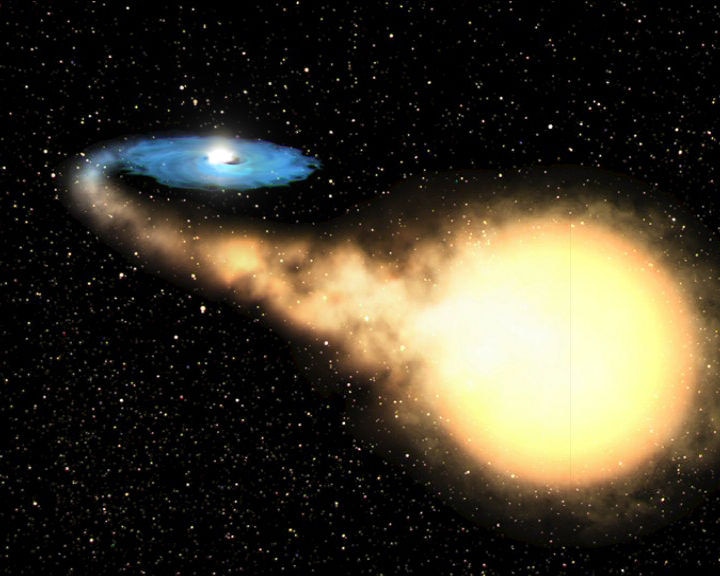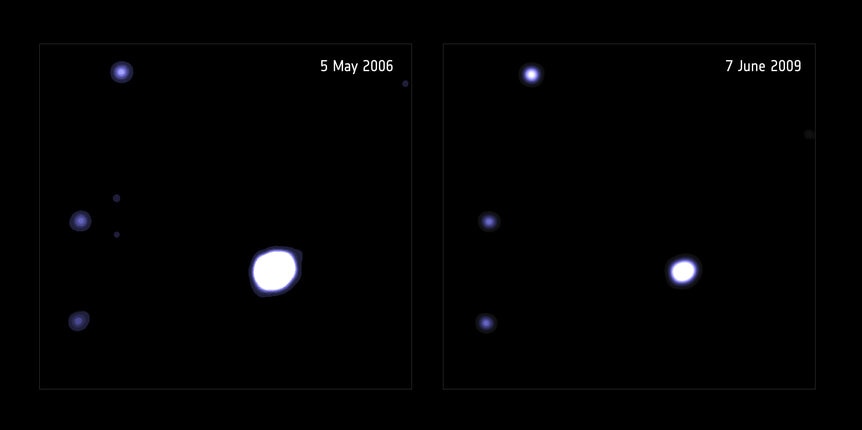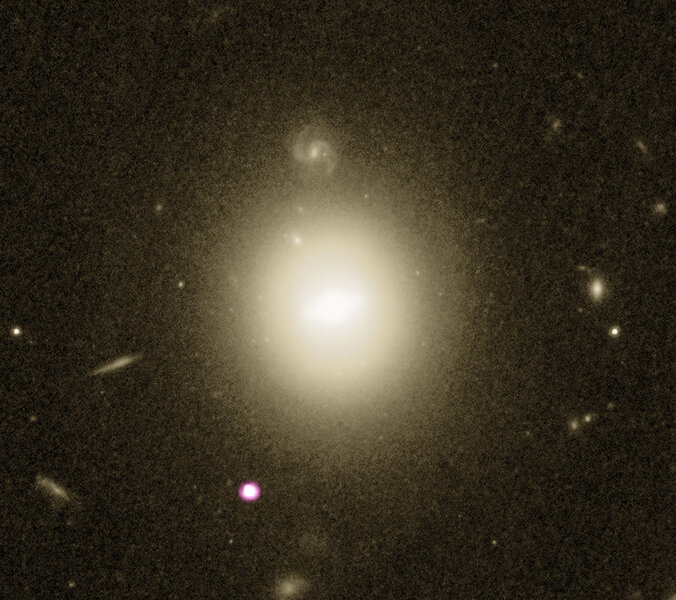Create a free profile to get unlimited access to exclusive videos, sweepstakes, and more!
Astronomers watch the aftermath of a star ripped apart by a middleweight black hole

If the title above sounds familiar, it's because I recently wrote about a star torn apart by a supermassive black hole in the center of one of a pair of colliding galaxies (collectively called Arp 299).
And now comes news of another, similar event. But the difference is a big one… or actually a medium one. It looks like the black hole that did the star-shredding was not a supermassive one, but instead more likely to be far lighter in stature, and be the best evidence so far that such a black hole even exists in the first place.
The kind of black hole you usually hear about has a mass of a few times to a few dozen times the mass of the Sun, and they're created (typically) when a high-mass star explodes in a supernova event. We call these stellar-mass black holes.
In the centers of galaxies are enormous black holes, the supermassive ones. These have millions or billions of times the Sun's mass.
It's been theorized that there is a third class, in between the two: Intermediate mass black holes (or IMBHs), with some thousands up to hundreds of thousands of times the Sun's mass. There have been lots of candidates found, objects that behave like these middleweights, but nothing conclusive has ever been seen.
Now we have another one to add to the pile.
First, although I explain it in the other article, here's a brief recap of an event so ridiculously violent that only astronomers could give it as bland a name as a tidal disruption event. Basically if a star wanders near a black hole, the side of the star closer to the black hole feels a stronger pull from gravity than the side of the star facing away from the black hole. If the star gets too close, this change in gravity (called the tide) is so strong it can overcome the internal gravity of the star itself. The star gets ripped apart, torn to vapor by the black hole.
You might want to read that again, because the words are a bit bloodless. But again: A star can be ripped to shreds by a black hole if it gets too close.
A lot of the material gets ejected by the energy of the event, while some falls down to the black hole, where it forms a swirling disk that gets intensely hot, so hot it emits X-rays. It can take years for this material to cool and fall into the black hole, so what you see (if you have a clear view) is a bright flash, followed by a decline in brightness than can take many years.
A team of astronomers decided to look for the signature of such events in X-ray data taken by the orbiting observatory XMM-Newton. And they found something that looked about right: An observation in 2006 showed a bright blob of hot material emitting X-rays, while a second observation in 2009 showed it had faded considerably. It was also seen in Chandra X-ray Observatory data in 2006.
The next step was to look for it using visible light telescopes. They searched Hubble data using the coordinates of the X-ray source, and happily found an observation of that area taken in September 2003. Right next to those coordinates is a big galaxy called 6dFGS gJ215022.2-055059 (named for the Six Degree Field Galaxy Survey, and its coordinates on the sky). It's what's called a barred lenticular, a lens-shaped galaxy with a rectangular bar of stars across its nucleus, and is about 800 million light years from Earth.
In the Hubble image, not far from the center of the galaxy, is a blob of light, and follow-up observations indicated it's most likely a dense cluster of stars — either a globular cluster or, more likely given its mass of about 10 million stars, the core of a small galaxy that was stripped of its outer stars by the larger galaxy.
At the time of the Hubble observations (September 2003) nothing odd was seen at that location. But then between May and November 2005 (two years after the Hubble observations) observations of that same part of the sky using the Canada France Hawaii Telescope detected an optical brightening of the blobby cluster, and also that it appeared bluer. By 2014 or so it was red again.
That's a big deal! Whatever caused the brightening and X-ray burst must have happened between September 2003 and May 2005. That narrows down the time of the event! The astronomers got follow-up observations using the Neil Gehrels Swift satellite and again with Chandra. When they looked at the data, it became clear they were seeing a colossal event, a tremendous blast of energy that then faded over several years.
Suspicious. There are other types of events that can do this (like, say, a blob of matter slamming into a neutron star), but nothing fit the observations better than — and it still chills me to write this — a star getting ripped in half by a black hole.
What makes this one special is the black hole itself. The temperature of the swirling disk of matter around the black hole depends on the mass of the hole itself; the smaller the black hole the hotter the disk gets (that math is somewhat complicated, but a smaller black hole has a steeper gravitational gradient as you get close to it, so the forces inside the disk heat it up more). So, by calculating the temperature of the disk, the astronomers could then find the most likely mass of the black hole.
And that's the big surprise: It's between 50,000 and 100,000 times the mass of the Sun. That's just the right range for an intermediate mass black hole!
That's very cool. Mind you, the black hole in Arp 299 that shredded a star has something like 20 million times the Sun's mass. So this really is a far more svelte object.
But that doesn't mean the event was any less violent. The energy peaked at 1043 ergs per second — nearly 10 billion times the Sun's output of energy! Summed up over the many years of the event, the star's catastrophic demise emitted far more energy than the Sun will over its entire lifetime.
I mean, seriously. Wow. These tidal disruptions are incredible events. But then, these happen when a star is completely torn apart. I get the willies just thinking about it.
So, is this proof that IMBH's exist? Well, not really. It's still an inference, an indirect observation. What might be a more solid case? A good one would be if we see a star zipping around in a circle (well, not directly, but by its Doppler shift) like it's in a binary system, but with no other star visible… and by measuring its velocity we find the mass of the invisible companion is in the range of an IMBH. That would be pretty convincing.
But that's still in the future. For now, what astronomers are doing is what we generally do when something new is afoot: Amass data piece by piece, building up a case, getting the evidence we need and refining the physics until we either accept these things exist, or come up with a better explanation… or that smoking 100,000-solar-mass gun turns up.
Until then, this is a pretty good case. Let's hope we find lots more.
















